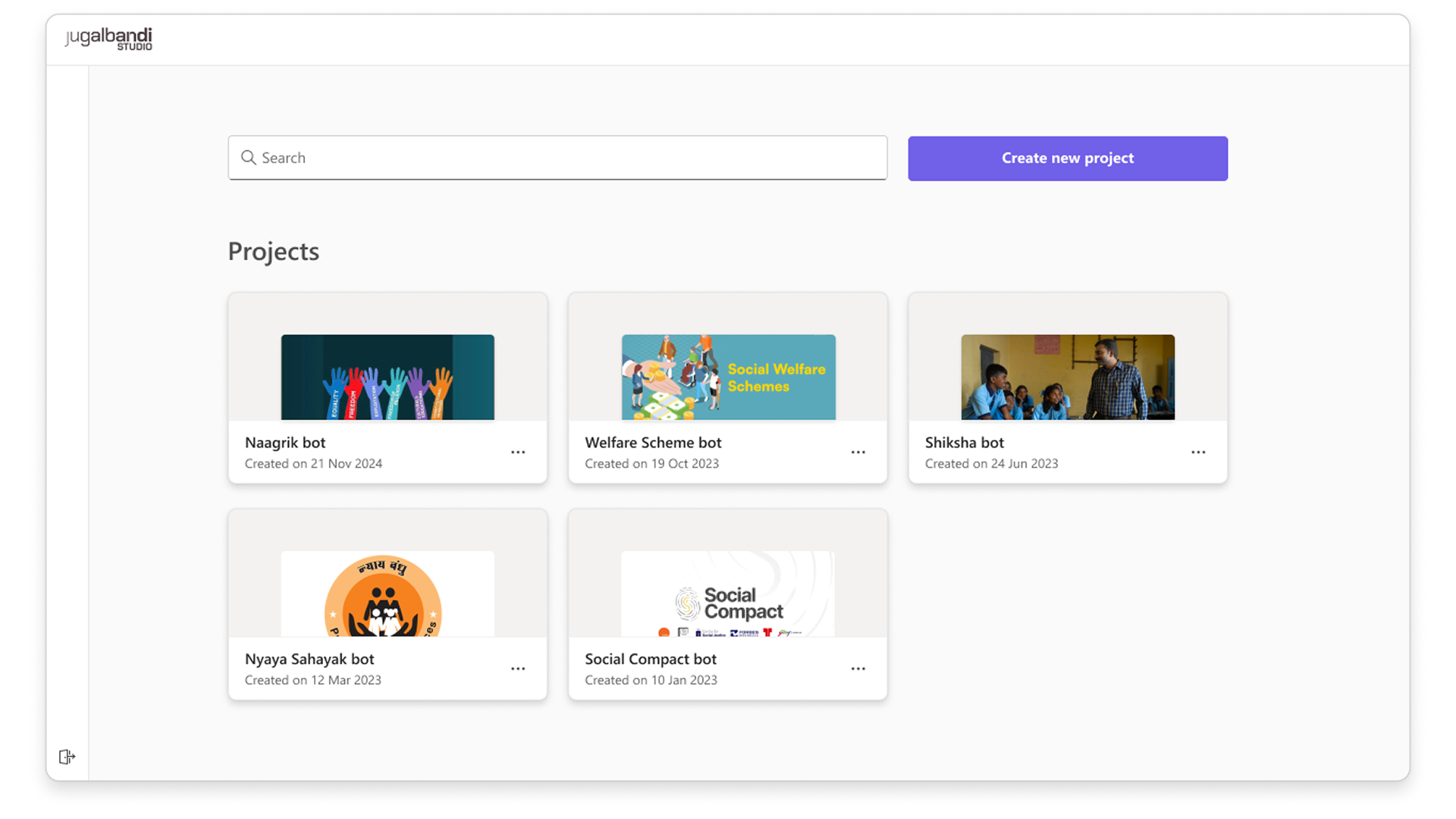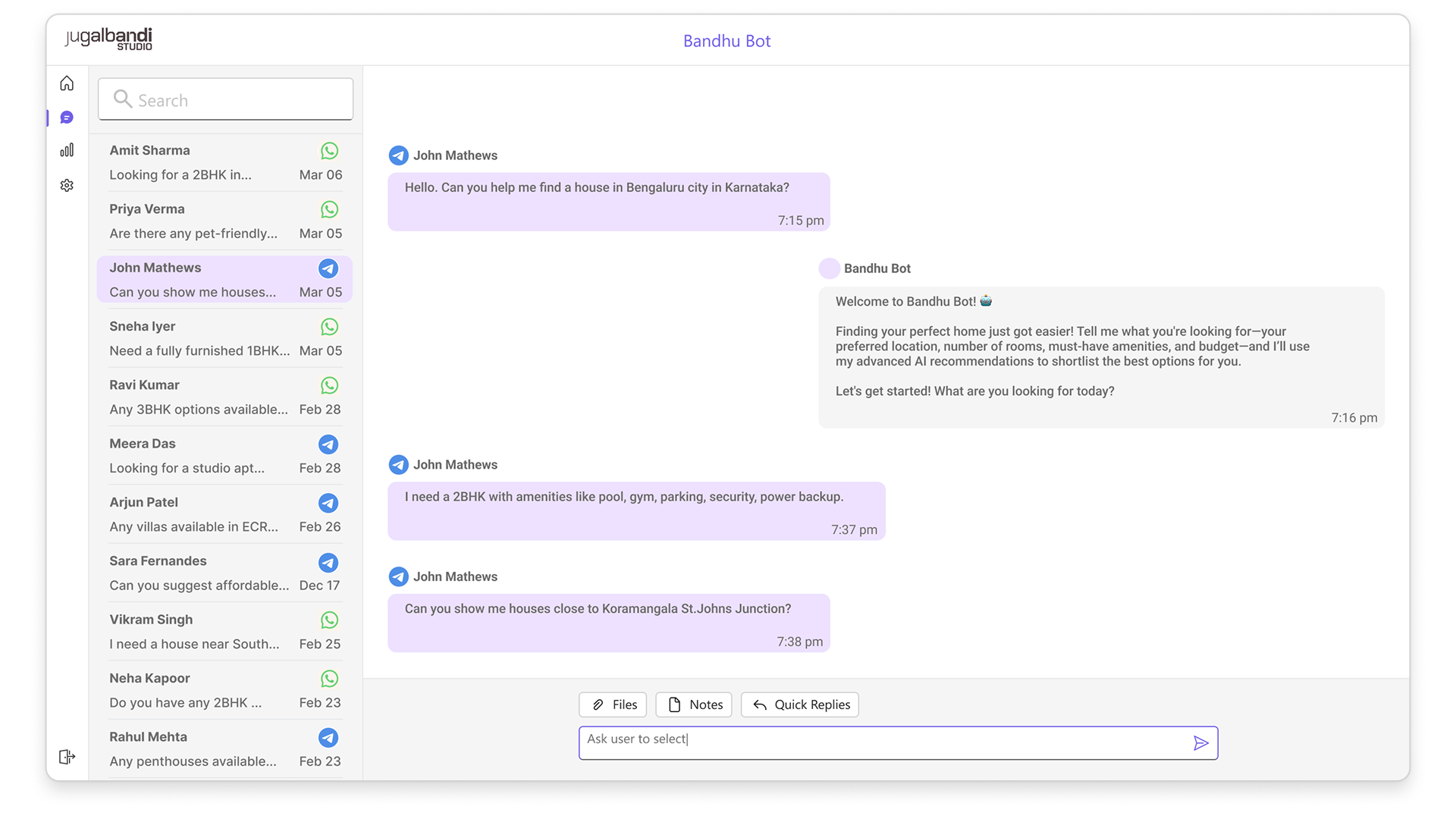Gen AI Chatbot Builder (OpenSource)
Microsoft (2023-24)
OVERVIEW
Summary
At Microsoft, I contributed to a few projects, with major focus on “Jugalbandi Studio”, an AI based no-code chatbot building platform aimed at democratizing software development. Its mission is to empower organizations lacking technical resources to transition their services online. Through collaboration with developers, NGOs, and government departments, I tailored the Studio's interface and user experience to address specific needs and pain points through iterative design.
My Role
Research, Ideation, Design &
User-testing for 0-to-1 platform.
The Team
5 AI Researchers &
5 Software Engineers.
Timeline
Oct 2023 - Nov 2024

Achievements ✨
CONTEXT
Partners & Clients
Many NGOs and Government departments approached Microsoft to enhance their outreach to the general public. To address this, we collaborated with other tech organisations to work towards a solution.


Let's start with a chatbot builder!
Chatbots have evolved from simple rule-based systems to sophisticated AI-driven platforms. With advancements in Gen AI, they can now handle complex interactions, multi-lingual support and provide personalized experiences, making them an ideal choice for organizations looking to expand their reach.

Problem Statement
Keeping this in mind, all our focus was now on solving one problem:

RESEARCH
What kind of studies are being done?
As part of Jugalbandi Studio and our ongoing work on HCI research paper,
I conducted an extensive review of 150+ academic papers to explore & understand the foundational approaches
in novice programming for conversational agent development.
Our key focus areas included:
- Novice Chatbot Development
- Conversational Programming
- No-code/Low-code Development

What is the state of current solutions?
To understand the market landscape, I examined products from similar domains, including chatbot builders, low/no-code tools, general-purpose generative AI, code generation AI, copilots, assistants, and generative AI studios.

What exactly do the organisations want?
I led an initial workshop with each client organization to thoroughly understand their needs and collaboratively create mockups of their envisioned chatbot solutions. These mockups were iterated and validated with clients, serving as a foundation for aligning our development team and partners on key platform features. This approach clarified the essential functionalities needed to empower novice developers in building effective chatbots on our platform.

Painpoints
Through my secondary and primary research, I was able to gather few painpoints to keep in mind while ideating for the platform. Some of the major painpoints and concers where:

Process
The process can be divided into two parts. I would gather client requirements and build mockups of their chat service. Using these as golden standard we would reverse engineer the features needed in our platform for building these chatbots. The second part of process is to ideate and iterate the platform's design.

Iterations
User Testing
We conducted multiple rounds of user-testing to validate our prototypes, test assumptions, and gather critical feedback.

Text Summaries
We introduced GenAI text summaries for code to ease code comprehension. Over the course, we had several iterations of it experimenting with formating of the text to see which one has maximum user satisfaction. We moved from single block to breaking into task flows and then eventually breaking into steps. Apart from this, we also converted technical jargons into simpler terms and introduced edit highlights.


Flow View
We introduced flow diagram view of the chatbot for a bird's eye view. My hypothsis was having it broken down into process flows would make it easier for the end users but was proven wrong on user testing as majority of users got confused when dealing with complex interconnected steps. Users were also confused when a new flow/process should begin and end. Our solution to this was to introduce a simpler step break down similar to the text summaries. We also added dead end highlighting and conditions in the connecting lines for easing comprehension.

Error Debugging
Users were overlooking errors in text summaries, so we introduced notifications whenever an error or warning was detected. To help users make informed decisions without breaking their focus to search for fixes online, we provided suggestions on how to resolve issues. Additionally, we added an error and warning counter to keep track of all detected issues at all times.

Plugins
Users can add Jugalbandi Feature (Plugins) to their chatbot using the library. Initially we were using forms to fill in data but users were confused on how to reference data that is already been collected and stored. Conversations allowed better interction and conveying of intent but too time consuming if there are many entries.

Prompt Support
I analyzed 200 user prompts and found that non-instructional queries were unanswered due to prompt constraints. To address this, we added support for code inquiry, tool help, and chatbot-related queries while maintaining restrictions on external queries to align with company compliance and ease developer effort.

Other Features
Once we started building out the platform, we needed to add flows and interfaces for supporting functionalities .
So I also worked on the following:

Impact
'Jugalbandi Studio', along with the dashboard 'Jugalbandi Manager' is in its pilot phase. Microsoft has handed over the development to Thoughtworks team who are working along with Government departments & NGOs to roll out chatbots to the citizens.

Evolution

UI Screens











TESTIMONIAL


REFLECTIONS

At Microsoft Research, I worked on diverse projects, each presenting unique challenges that honed my ability to prioritize tasks and stay focused.
Regularly presenting to senior leadership enhanced my confidence in communicating design decisions clearly and addressing constructive feedback effectively.
By creating tailored deliverables for stakeholders and leveraging my coding skills, I bridged the gap between design and development. This approach fostered smoother collaboration with engineers and ensured that designs were implemented seamlessly.
Coordinating with various organizations strengthened my stakeholder management skills and deepened my ability to navigate cross-functional partnerships.
Additionally, conducting extensive research in conversational design allowed me to make more strategic and informed design decisions.
This experience sharpened both my design expertise and leadership abilities, equipping me to take on complex, multidisciplinary challenges with confidence.






